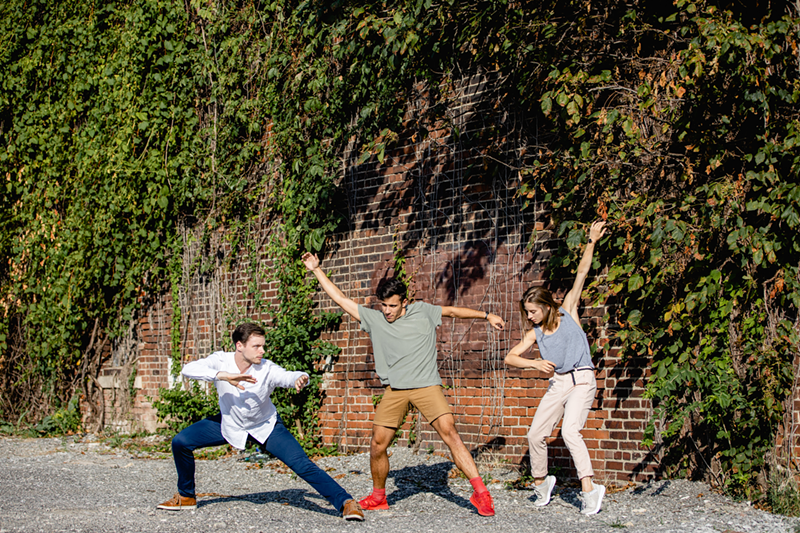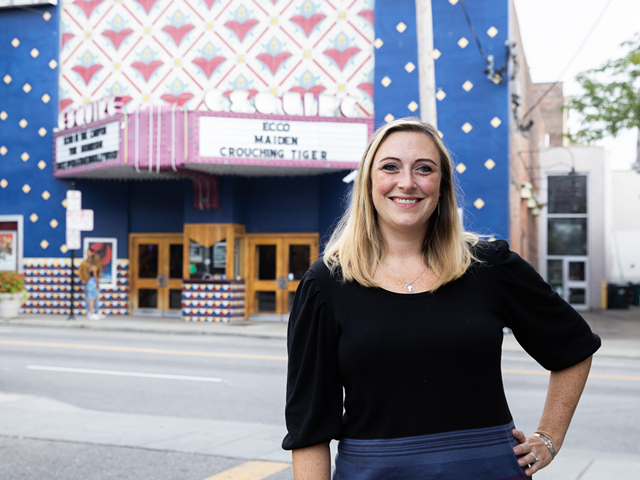Three dancers are taking the stage this fall in more ways than one. When Cincinnati Ballet’s 14th Kaplan New Works Series opens on Sept. 12 at the Aronoff Center for the Arts in the Jarson-Kaplan Theater, three of its company members will have their own choreography featured.
Soloist David Morse and corps de ballet dancer Taylor Carrasco both had pieces featured in the 2018 iteration of the beloved program that offers contemporary works in an intimate setting. For principal dancer Melissa Gelfin, this is her New Works choreographic debut, and a very personal one at that.
“My piece was more or less inspired by — gosh, this is going to sound really dark. The death of my grandmother came really close to the death of my dad,” Gelfin says. “My dad passed away; he was in the ICU and my grandmother had just gotten out of surgery for her brain tumor one floor below. Here was this pressure all of a sudden I felt, with time.”
Gelfin’s father passed away on Dec. 10, 2017, and her grandmother on April 1, 2018. She describes time itself as simultaneously slowing down and moving normally during this period of her life, an understandable reaction to the shock of loss. She was fascinated by the pressure of time and how it relates to humans and the many relationships we have — parental, romantic, etc.
“Ever since those moments, (time) just gets me in a different way,” she says. “It was a very strange concept for me to deal with and process, so this is how I’m processing.”
Gelfin recently contributed a solo piece to elle émerge, Houston Ballet’s all-female choreographic workshop, alongside Cincinnati Ballet’s resident choreographer Jennifer Archibald and several others.
She also participated in Cincinnati Ballet’s annual Choreographer’s Workshop, an opportunity for company dancers to flex their choreographic muscles. Held annually in the spring since 2015, the workshop is evaluated by a distinguished panel of choreographers and dancers, and in the first two years, concluded with a free in-studio performance. In 2017, the stakes were upped when it was announced that two works would be selected from the workshop to go onto mainstage performances in New Works. This spring, artistic director Victoria Morgan knew she had to add a third — Gelfin’s.
“She’s got a special touch,” Morgan says. “I just felt that she’s got so much potential. It’s very individual, a lot of undulations in it, a lot of use of flex foot, and turned in, and on the floor. It’s all very sensual. She’s titled it Clockwise and she has a very interesting orientation about time. The piece has a lot of references to the past and the present and the future, and trying to find a place to stop that basically stops the inevitable action from happening. I love it.”
Morse also found himself working out big questions about the afterlife through choreography in his currently untitled work. Inspired by C.S. Lewis’s book A Grief Observed, which was written following the death of his wife, Morse’s piece focuses less on the reactions we have to the death of our loved ones and more about how they feel after they’ve passed on — what Morse calls “spiritual grieving on the other side of the death marker.”
“I’m trying to take (four dancers) and meld them into one organism that is the spirit of this person who’s passed,” he says.
Gathering, his 2018 New Works piece, was electrifying; it was the stand-out in an evening full of stand-outs. His unique choreographic voice, both intentional and controlled, seems destined for more cultivation and performance — and is one upon which Morgan heaps praise.
“It’s interesting to me, because when I watch choreographers in the early stages, their work looks a little bit like this choreographer and that choreographer, but I feel like David’s looks so stylistic, so developed,” she says. “You look at a Monet, a Picasso, and go, ‘Oh, I know who that is,’ and I think David has that already. He’s a young voice, but he’s very deliberate and studied and creative.”
Carrasco’s second New Works contribution started with a song. He is usually inspired by music first, and this year’s piece features “Four Friends,” by Ghost Quartet, a fun, folky tune that praises four different types of whiskey. In searching for other similar strains of music, Carrasco found his choreographic storyline to be exploring addiction.
“It turned into a meditation on cyclical, addictive behavior that almost all of us have, whether that be an addiction to cigarettes, or alcohol, or a person,” he says. “You’re always searching for something better when it comes to dealing with an addiction, whether you’re deciding to step away from or fall back into your addiction. I just think that’s a very interesting, human consistent tendency.”
His energy is young and propulsive, and Morgan describes him as very dedicated.
“He’s somebody who really wants to choreograph,” she says. “Usually people are taking their lunch break at the 1:45 hour, but I look down from my little perch here and I often see him just in the studio, making stuff up. Just exploring, just being really physical. Sometimes he’ll grab another dancer so they can play with the improvisational stuff and feeding off each other. He just is compelled.”
For any dancer, being on the mirror side of the studio as choreographer, is an interesting, sometimes unfamiliar change of pace.
“I wanted to put my socks on and jump in but I was like, ‘Wait a second, that’s me, I need to be the one up front,’ ” Gelfin says.
Leading dancers who are colleagues makes Morse, Carrasco and Gelfin particularly well-positioned to draw the most out of their dancers.
“You’ve watched them, you’ve danced with them, you know on a very deep level how they move, what’s a strength, what will look really great,” she says.
Morse adds that the product is the choreographic process itself, something that took both him and Carrasco a little time to learn last go-around, and all three choreographers emphatically agree. The advantages of their respective opportunity to choreograph on their home turf are not lost on any of them.
“All three of us are able to be really jump-starting our choreographic careers in an environment where we know that we’re supported by the artistic staff, we know that we’re supported by the dancers,” Carrasco says. “Not that it’s not high pressure, but it’s not like we’re going out of our environments. We’re in our home studio. It’s pretty incredible.”
Cincinnati Ballet’s Kaplan New Works Series takes place Sept. 12-22 at the Aronoff Center’s Jarson-Kaplan Theater. More info/tickets: cballet.org.






